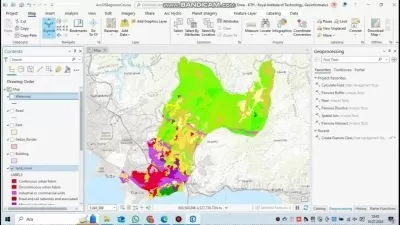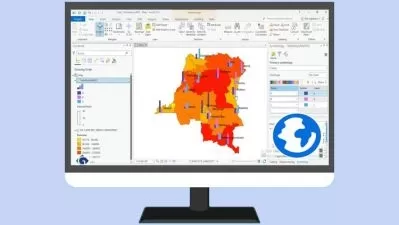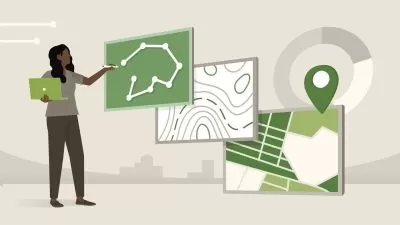ArcPy for Data Management and Geoprocessing with ArcGIS Pro
Glen Bambrick
9:47:19
Description
Learn the fundamentals of ArcPy for data creation, management, manipulation, and querying using geoprocessing tools.
What You'll Learn?
- Leverage ArcPy for Geospatial Data Management workflows.
- Learn the fundamentals of ArcGIS Pro Geoprocessing tools using ArcPy.
- Become familiar with ESRI documentation for ArcPy Geoprocessing tools and functions.
- There's many ways to achieve a similar output, ArcPy offers many tools to achieve your goal.
- Complete workflows that chain multiple Geoprocessing tasks.
- Create a custom ArcTool for use in ArcGIS Pro
Who is this for?
What You Need to Know?
More details
DescriptionWant to stand out from the crowd? A little code goes a long way! Gaining an understanding of ArcPy and how to apply automation with regards to geospatial data management, data manipulation, and analysis via Geoprocessing tools will aid with standing out from the crowd and get you noticed. ArcPy is in high-demand, so up-skill today and put yourself in this high-demand category.
ArcPy is a fantastic ally for all your daily ArcGIS Pro tasks. This course will initially focus on using ArcPy for data management. Data management is often one of the most overlooked aspects of GIS and unfortunately can be the difference between a good GIS and a bad one. Good data practices open up the door for even better automation.
Lists are a big factor in ArcPy workings. You will look at creating lists of various objects such as workspaces, feature classes, and fields for examples, and perform actions on different elements. You will look at using ArcPy to describe the various elements and use lists and descriptions to generate a comprehensive data catalogue.
Adding to the data management side, the course slides into data validation rules with domains and subtypes. Domains are used to constrain the value allowed for a particular field. Basically, they enforce data integrity. You will look at the whole suite of tools available for domains, from creating and altering, to applying to a field. Subtypes are used to categorize your data. Think of a road network, you can categorize roads into primary, secondary, and tertiary roads for example. You can set defaults values on fields in each subtype category that is automatically applied when creating a new feature. Subtypes can be used in tandem with domains to improve data integrity.
No we're getting into the heart of things. ArcPy is a great tool for creating templates and standardising your data structures. You will create a file geodatabase, a feature dataset, and a set of feature classes, all using ArcPy. We will take you through adding fields and take a look at a long list of tools associated with fields, from the Field Object itself, to creating a field (Add Field), altering a field, assign a default, field calculations, and mapping fields from one tool to another.
There's no getting away from Excel in today's GIS society. This course will embrace that fact here and look at some conversion tools; Table to Excel, Excel to Table, and the Export Table that allows a more diverse choice such as a CSV. You will create a point dataset from an Excel file and save it to memory showcasing several tools that get the job done. ArcPy offers an array of data conversion tools.
I'd like to say that cursors are the main event but that would be doing the rest of the material a huge injustice. Cursors will rapidly become a daily routine in your ArcPy life. Cursors are used to read and write attributes and geometries. You can use the Search Cursor to read through a dataset, the Update Cursor to update attributes and geometries, and the Insert Cursor to add new records.
ArcPy boasts a host of general data tools to aid with data management, processing, and workflows. We will dive into them and perform checks; such as whether a dataset or data structure exists, testing for a schema lock; this is often the crux of geoprocessing that the data is locked, join datasets based on a common field, merge and append data.
Where would we be without the analysis tools provided by ArcGIS Pro? What about everyone's ultimate favourite tool, the Buffer? Well, we can use ArcPy for that too, and many more. ArcPy provides the bed for repeatable geospatial analysis through automation.
Selecting data with ArcPy enables you to perform geoprocessing tasks on the subset. The most notorious are Select Layer by Attribute and Select Layer by Location, but there are others patiently waiting their turn to be called into an ArcPy script.
Finally, you will create a custom ArcTool for use in ArcGIS Pro as a GUI and chain geoprocessing tasks to achieve a desired output.
This course uses PyScripter to write the Python code. You can use any code editor software that you prefer. The course solely focusses on ArcPy and no other third-party modules are utilized.
The ArcPy for Data Management and Geoprocessing with ArcGIS Pro course requires a Basic license for ArcGIS Pro. Only tools and workflows that can be performed at the basic license level are used and assessed during the course.
Please Note! ArcGIS Pro requires a license to use which is a paid license. You can get a 21-day free trial, or you can get a Personal Use license for a fraction of a Commercial license.Â
It is recommended to get the free trial if you have no other access to ArcGIS Pro software.
Your course instructor, Glen Bambrick, has over 15 years' experience with GIS and geospatial data, with over half of those years utilizing ArcPy on major projects to standardize and automate workflows.
By the end of this course... you will be fully armed with the fundamentals of ArcPy for data management, manipulation, creation, analysis, and to perform repetitive workflows. You will have a deep understanding of capabilities of ArcPy and some knowledges of the nuances that can be encountered and how several tools can be used to achieve the same or similar output.
The ideal student for this course would have some basic knowledge of Python and is somewhat familiar with ArcGIS Pro. No knowledge of ArcPy is necessary, after all, that is what this course is for.
Want to stand out from the crowd? Well what are you waiting for?
Who this course is for:
- ArcGIS Pro users who want to begin their automation adventures with ArcPy.
- Geospatial Professionals who want to improve and innovate data management processes.
- GIS Analysts who want to automate repetitive Geoprocessing tasks.
Want to stand out from the crowd? A little code goes a long way! Gaining an understanding of ArcPy and how to apply automation with regards to geospatial data management, data manipulation, and analysis via Geoprocessing tools will aid with standing out from the crowd and get you noticed. ArcPy is in high-demand, so up-skill today and put yourself in this high-demand category.
ArcPy is a fantastic ally for all your daily ArcGIS Pro tasks. This course will initially focus on using ArcPy for data management. Data management is often one of the most overlooked aspects of GIS and unfortunately can be the difference between a good GIS and a bad one. Good data practices open up the door for even better automation.
Lists are a big factor in ArcPy workings. You will look at creating lists of various objects such as workspaces, feature classes, and fields for examples, and perform actions on different elements. You will look at using ArcPy to describe the various elements and use lists and descriptions to generate a comprehensive data catalogue.
Adding to the data management side, the course slides into data validation rules with domains and subtypes. Domains are used to constrain the value allowed for a particular field. Basically, they enforce data integrity. You will look at the whole suite of tools available for domains, from creating and altering, to applying to a field. Subtypes are used to categorize your data. Think of a road network, you can categorize roads into primary, secondary, and tertiary roads for example. You can set defaults values on fields in each subtype category that is automatically applied when creating a new feature. Subtypes can be used in tandem with domains to improve data integrity.
No we're getting into the heart of things. ArcPy is a great tool for creating templates and standardising your data structures. You will create a file geodatabase, a feature dataset, and a set of feature classes, all using ArcPy. We will take you through adding fields and take a look at a long list of tools associated with fields, from the Field Object itself, to creating a field (Add Field), altering a field, assign a default, field calculations, and mapping fields from one tool to another.
There's no getting away from Excel in today's GIS society. This course will embrace that fact here and look at some conversion tools; Table to Excel, Excel to Table, and the Export Table that allows a more diverse choice such as a CSV. You will create a point dataset from an Excel file and save it to memory showcasing several tools that get the job done. ArcPy offers an array of data conversion tools.
I'd like to say that cursors are the main event but that would be doing the rest of the material a huge injustice. Cursors will rapidly become a daily routine in your ArcPy life. Cursors are used to read and write attributes and geometries. You can use the Search Cursor to read through a dataset, the Update Cursor to update attributes and geometries, and the Insert Cursor to add new records.
ArcPy boasts a host of general data tools to aid with data management, processing, and workflows. We will dive into them and perform checks; such as whether a dataset or data structure exists, testing for a schema lock; this is often the crux of geoprocessing that the data is locked, join datasets based on a common field, merge and append data.
Where would we be without the analysis tools provided by ArcGIS Pro? What about everyone's ultimate favourite tool, the Buffer? Well, we can use ArcPy for that too, and many more. ArcPy provides the bed for repeatable geospatial analysis through automation.
Selecting data with ArcPy enables you to perform geoprocessing tasks on the subset. The most notorious are Select Layer by Attribute and Select Layer by Location, but there are others patiently waiting their turn to be called into an ArcPy script.
Finally, you will create a custom ArcTool for use in ArcGIS Pro as a GUI and chain geoprocessing tasks to achieve a desired output.
This course uses PyScripter to write the Python code. You can use any code editor software that you prefer. The course solely focusses on ArcPy and no other third-party modules are utilized.
The ArcPy for Data Management and Geoprocessing with ArcGIS Pro course requires a Basic license for ArcGIS Pro. Only tools and workflows that can be performed at the basic license level are used and assessed during the course.
Please Note! ArcGIS Pro requires a license to use which is a paid license. You can get a 21-day free trial, or you can get a Personal Use license for a fraction of a Commercial license.Â
It is recommended to get the free trial if you have no other access to ArcGIS Pro software.
Your course instructor, Glen Bambrick, has over 15 years' experience with GIS and geospatial data, with over half of those years utilizing ArcPy on major projects to standardize and automate workflows.
By the end of this course... you will be fully armed with the fundamentals of ArcPy for data management, manipulation, creation, analysis, and to perform repetitive workflows. You will have a deep understanding of capabilities of ArcPy and some knowledges of the nuances that can be encountered and how several tools can be used to achieve the same or similar output.
The ideal student for this course would have some basic knowledge of Python and is somewhat familiar with ArcGIS Pro. No knowledge of ArcPy is necessary, after all, that is what this course is for.
Want to stand out from the crowd? Well what are you waiting for?
Who this course is for:
- ArcGIS Pro users who want to begin their automation adventures with ArcPy.
- Geospatial Professionals who want to improve and innovate data management processes.
- GIS Analysts who want to automate repetitive Geoprocessing tasks.
User Reviews
Rating
Glen Bambrick
Instructor's Courses
Udemy
View courses Udemy- language english
- Training sessions 128
- duration 9:47:19
- Release Date 2023/07/10










